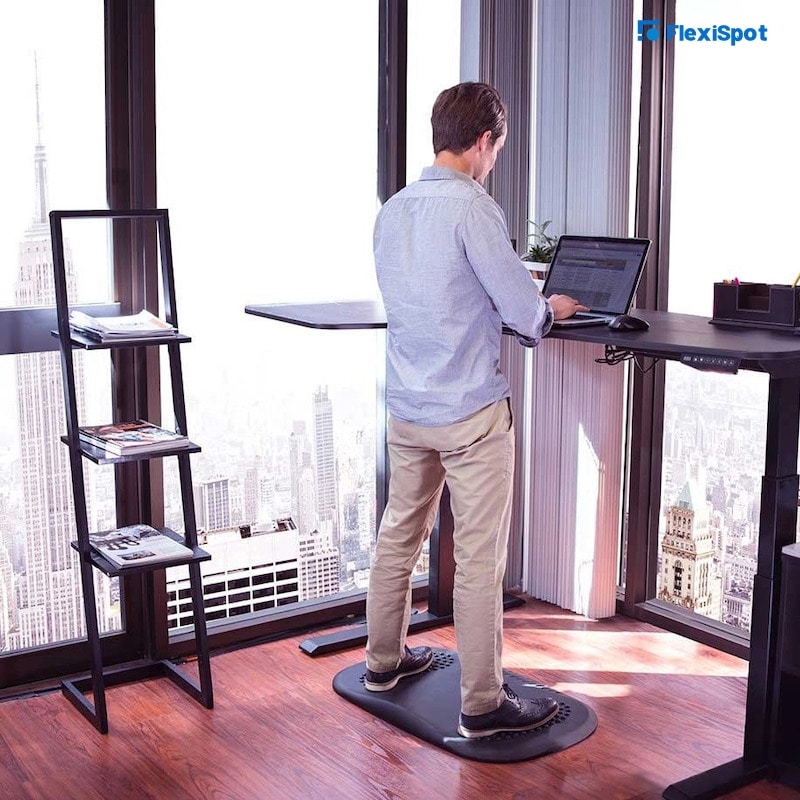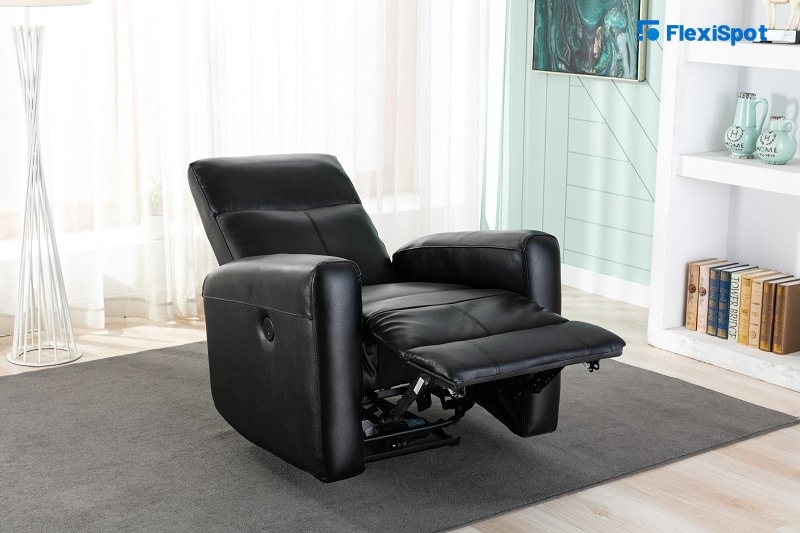Neck, shoulder, and pains in the upper body are common with people that work on office desks. However, they worsen with time because most people deal with the symptoms and not the root cause.
We’ll cover the cause and furnish the reader with remediation tactics that are sure to do away with the problem.
What are the Root Causes of Shoulder Pain in Office Workers?
The complex structure of the shoulder encompassing muscles and tendons is the reason your shoulder sustains pain and sometimes even serious injuries. Shoulder pain ranges from a mild ache to a chronic burning sensation.
Shoulder pain usually stems from prolonged movements causing repetitive strain on the muscle ligaments and tendons adjoining the shoulder joints. In chronic shoulder pain, the shoulder joint’s menisci, cartilage, and bones are usually injured.
Small, persistent, repetitive movements on the office desk, such as typing on a keyboard or using a mouse, are the major cause of shoulder pain in the office. This type of shoulder pain caused by such movements is referred to as cumulative trauma disorder or repetitive strain injury (RSI). In RSI, the tendons and muscles of the shoulder are strained to the repetitive movements leading to chronic shoulder pain.
Shoulder pain in office workers often develops gradually rather than emerge all at once. Usually, the sedentary lifestyle synonymous with office workers causes weakening of body muscles, making them more susceptible to muscles and joint pain, including shoulder pains. The primary causes of shoulder pain in office workers include:
Poor sitting posture
Working under extreme temperature
Numerous repeated overhead movements causing increased pressure on the shoulder
Mechanical contact stress is caused by the wrists resting on a sharp and hard desk edge for quite some time.
Prolonged sitting or standing
Repeated phone calls while tilting your head to hold the phone between your neck and shoulder
Lack of frequent exercises to stretch the shoulder muscles. Some exercises that can alleviate shoulder pain include cervical retraction, backstretch, armpit stretch, shoulder rolls, upper trap stretch, and chin tuck.
Poor sleeping posture or sleeping on a worn-out mattress.
Types and Severity of Shoulder Pain
There are three primary types of shoulder pain: achy pain, radiating pain, and burning pain.
Achy Shoulder Pain
Achy shoulder pain is a dismal or deep sense of pain that is challenging to pinpoint the exact location on the shoulders. This type of shoulder pain is usually associated with a number of shoulder injuries and conditions, including:
Rotator cuff tear- Caused by a traumatic event such as a fall leading to the degradation of the rotator cuff tendons with time.
SLAP tear- SLAP tear is the sprain of the cartilage that surrounds the shoulder's socket. It results in a deep, achy shoulder pain that is difficult to pin down. The pain is usually felt at the back of the shoulder but may sometimes be felt at the front of the shoulder if the biceps tendons are also torn. SLAP tears can develop gradually over time due to repetitive activities or come about instantly due to an acute injury such as a fall.
Frozen shoulder- Frozen shoulder is a shoulder condition that usually affects people aged between 40 to 60 years, causing achy pain on the shoulders and, in some cases, the upper arm.
Glenohumeral osteoarthritis- Achy shoulder pain can cause the inflammation of the shoulder cartilage, a condition referred to as Glenohumeral osteoarthritis (shoulder joint arthritis). This condition is commonly seen in older adults above 50 years old. However, it can also be seen in younger adults, especially after a shoulder fracture or dislocation.
In most cases, achy shoulder pain is usually severe and often occurs following a traumatic event such as a direct injury to the shoulder or a fall.
Radiating Shoulder Pain
Radiating shoulder pain is not directly felt on the shoulder. The pain originates from the shoulder but is felt in the neck or arm. The common causes of radiating shoulder pain include:
Arthritis- Inflammation of the acromioclavicular joint (arthritis) in the shoulder cases radiating pain which is felt in the neck. Arthritis of the acromioclavicular joint is usually caused by increased pressure or force on the shoulders.
Rotator cuff tendonitis- The inflammation of the rotator cuffs in the shoulder results in radiating pain, which is felt from the exterior of the arm adjacent to the topmost part of the shoulder. This condition is caused by repetitive strain of the arm in activities such as swimming, weightlifting, typing, etc.
While it's not severe, it's difficult to diagnose since the pain is felt somewhere else. In some instances, radiating pain in the shoulder is caused by neck injuries such as brachial plexus injury and cervical radiculopathy. <
Burning Shoulder Pain
Burning shoulder pain is usually severe and feels like an endless burning sensation in the shoulders. In earlier stages, the pain feels like a dull ache but develops into an irritating, inflamed pain over time. Sometimes, the burning pain may be radiated to the upper arm. Some causes of burning shoulder pain include subacromial bursitis and rotator cuff tear.
6 Tips that Will Help You Alleviate Shoulder Pain
Nearly all office workers experience shoulder pains thanks to a sedentary lifestyle. Shoulder pains can be detrimental to your productivity, let alone your overall health. If you’re experiencing shoulder pains, the good news is that there are several things you can do to overcome such pains and lead a healthy and productive lifestyle. From exercising to using ergonomic office furniture, check out these 6 tips to help you alleviate shoulder pain.
Posture Correction
If you're suffering from constant shoulder pains, the chances are high that you're sitting in the wrong posture. It's normal to hunch or slouch during prolonged sitting, especially when fatigue sets in. However, such poor postures strain the body leading to pains at different body parts, including the shoulder.
Therefore, to avoid shoulder pain, it's crucial that you sit correctly. Correct posture alleviates the constant strain on your shoulders and neck, ensuring the muscles are relaxed. Follow the steps below when sitting to attain the correct posture.
Let your feet lie flat on the floor or footrest. If you're using a footrest, ensure it's stable.
Push your hips toward the back of your chair. Ensure your thighs are parallel to the ground.
Ensure your office chair supports your lower back. To achieve this, you may need an ergonomic chair such as FlexiSpot’s Big and Tall Reclining Executive Office Chair.
Place your elbows close towards your body and preferably supported. Your hands and wrists should be placed in line with your forearms.
Finally, ensure your shoulders are relaxed but not rounded.
In case you’re standing, try not to slouch. You may also want to stand on an anti-fatigue mat or any other soft surface while wearing comfortable shoes. If you’re sitting, try to stand, walk around, come back and reset your sitting position into the correct posture.
Ergonomic Furniture
For any office worker, the importance of ergonomic office furniture cannot be overemphasized. Ergonomic office chairs are designed to maintain the body's natural posture, enabling you to maintain a correct and comfortable sitting position, which comes in handy to reduce shoulder pain.
An ergonomic standing desk can also prevent shoulder pains by allowing you to stand at certain intervals while working, cutting down on the enormous amount of time you spend sitting. Remember, prolonged sitting has been directly linked to back and shoulder pains. Instead of sitting for long hours, you can seamlessly raise the desk's level to the correct level and continue working while standing. Regular standing while working eases pressure and strain on your shoulders, back, and other body parts.
If you’re considering an ergonomic office chair, the Big and Tall Reclining Executive Office Chair with Footrest 290 from FlexiSpot is your best bet. This chair is not only affordable but also offers plenty of benefits thanks to its incredible features such as 90-135 degrees adjustable back angle, adjustable seat height, 360-degree swivel with lumbar support knob, and an extra comfy footrest coupled with a waterfall seat edge for next-level comfort.
If you’re spoilt for choice, you could also consider the Leather Massage recliner 9086 constructed from premium grade leather and high-end PVC materials. Incorporating a 2-point massage function, this recliner seat takes comfort to a whole new level.
Scheduled Breaks
Do you take regular breaks as you work? Sitting in one position for too long causes static loading-a situation where the muscles are made to hold your body in one position for quite some time, leading to fatigue and pain in different body parts, including the shoulder.
The best way to prevent static loading is to take regular breaks in the course of your workday. The breaks may depend on how busy your schedule is. For instance, you can decide to work for 1 hour then take a 3-5 minutes break, maybe to stretch out, walk around the office, visit the washroom or refill your water bottle or coffee cup. Taking regular breaks will prevent static loading, prevent prolonged sitting, and ensure you don't assume a wrong sitting posture due to fatigue. Besides, you'll be more productive when taking regular breaks since you'll be able to focus more.
Perform Shoulder Exercise at Your Desk
In the realms of a sedentary lifestyle, regular exercise is necessary to keep one active and healthy. Conversely, regular exercise can alleviate shoulder pain by easing muscles and reducing pressure build-up. Exercising also strengthens the muscles and makes them less susceptible to forces that make them ache.
For office workers with a hectic schedule, you really don't need to hit the gym to exercise for office workers with a hectic schedule. There are simple yet helpful exercises you can perform right at your office desk. They include cervical retraction, backstretch, armpit stretch, shoulder rolls, upper trapezius stretch, chin tuck.
Apart from these exercises, you can also practice active sitting. For instance, you can stretch out to pick a pen, swivel your seat from side to side and lean back on your chair occasionally. In addition to alleviating shoulder pain, regular exercise improves your mood and makes you more productive.
Get a Mattress that Will Enhance Sleep Quality
Your mattress could be the cause of your shoulder pain, especially if you feel increased shoulder blade pain at night. If your mattress is worn out or too soft, it may not offer adequate support or pressure relief, causing the delicate parts of the shoulder to experience some form of strain. Equally, if your mattress is too firm, it may be pressing hard against the delicate shoulder muscle, aggravating the pain.
Replacing your mattress with an orthopedic or pressure-relieving mattress will offer optimal support and relieve shoulder pain. Besides, you can try to sleep on your back or the opposite shoulder in case the right/left one hurts. You may also want to place a pillow under or between your knees for added sleeping comfort.
Seeking Professional Help
In some instances, chronic shoulder pain may be due to an underlying medical condition such as Glenohumeral osteoarthritis and rotator cuff tendonitis. If you've tried exercising, bought ergonomic office furniture, and even replaced your mattress, but the shoulder pain still won’t go away, you may want to seek professional help for further medical assistance.
A doctor will subject you to a series of tests and imaging to establish the exact cause of the pain and treat it accordingly. What's more, you will be advised accordingly on what you need to do or what further medical steps need to be undertaken to ease the shoulder pain.
Conclusion
Due to their sedentary lifestyle, office workers are predisposed to body pains, including back pains, neck pains, shoulder pains, etc. Shoulder pains can reduce one productivity, not to mention that it puts an individual at risk of other fatal health conditions.
Thankfully, it’s possible to alleviate shoulder pains by undertaking small yet crucial changes to your lifestyle. For instance, you can exercise regularly, ensure you always sit correctly, and obtain ergonomic office chairs such as the Big and Tall Reclining Executive Office Chair with Footrest 290 and Leather Massage recliner 9086.
Going forward, it's crucial to implement these tips early enough to avoid chronic shoulder pain, which could develop into fatal health conditions.











